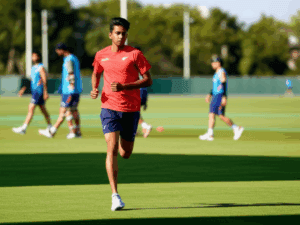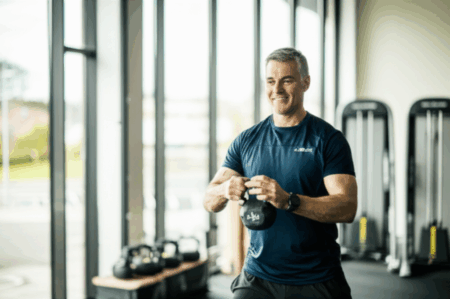Maintaining good physical fitness, specifically muscular strength and cardiorespiratory fitness, appears to be significantly linked to a reduced risk of mortality in individuals diagnosed with cancer, according to recent studies. This highlights the potential of incorporating targeted exercise programs into cancer care plans.
The Link Between Fitness and Cancer Mortality
Several research endeavors have explored the association between physical fitness metrics and survival rates among cancer patients. The emerging consensus suggests that patients exhibiting higher levels of both muscular strength and cardiorespiratory fitness demonstrate a better overall prognosis and a lower risk of death. This is a notable finding because, historically, cancer treatment has often focused primarily on therapies such as chemotherapy, surgery, and radiation, with less attention on the vital role of physical activity.
Muscular Strength and Its Impact
Muscular strength, often measured by tests of grip strength or the ability to lift weights, has been identified as an independent predictor of mortality. Patients with higher muscle mass and strength tend to have more favorable outcomes. The benefits are thought to stem from the metabolic benefits of muscle tissue, which plays a significant role in glucose regulation and the body’s inflammatory response, both of which can be negatively impacted by cancer and its treatment.
Cardiorespiratory Fitness and its Impact
Cardiorespiratory fitness, frequently assessed through measures like VO2 max (maximal oxygen uptake) during exercise testing, is another key player in the equation. Higher cardiorespiratory fitness levels mean that the heart and lungs are more efficient at delivering oxygen to the body’s tissues. This is crucial for maintaining overall health, especially during the rigors of cancer treatment. This can result in a reduction of the risk of complications that can arise from the disease and its therapies.
How Exercise Can Help
The evidence points towards the crucial role of regular exercise in improving fitness outcomes for cancer patients. Here’s how different types of exercise can contribute:
Resistance Training
Resistance training, which focuses on using weights or resistance bands to build muscle, plays a significant part in improving muscular strength. This type of exercise can counteract the muscle loss often experienced during cancer treatment, thereby improving physical function and potentially boosting survival outcomes.
Aerobic Exercise
Aerobic activities such as brisk walking, cycling, or swimming are vital in enhancing cardiorespiratory fitness. These exercises improve the capacity of the heart and lungs and help combat fatigue, a common side effect of cancer treatment. By incorporating aerobic exercise, patients can also improve their overall quality of life.
The Importance of a Personalized Approach
It is crucial to emphasize that exercise programs should be tailored to the individual needs of each cancer patient. Factors such as the type and stage of cancer, treatment plan, and overall health status must be taken into account. It’s advisable for patients to consult with healthcare professionals, including oncologists and physical therapists, to develop a safe and effective exercise regimen.
Specific Considerations
- Type of Cancer: Different cancers may present unique challenges, requiring specific exercise modifications. For example, patients with bone metastases might need to avoid high-impact exercises.
- Treatment Phase: The appropriate type and intensity of exercise can vary depending on whether a patient is undergoing active treatment, in remission, or in palliative care.
- Individual Capacity: Exercise programs should respect each person’s current fitness level and capacity for exercise. Starting gradually and progressively increasing activity can prevent injuries.
The Role of Healthcare Providers
Healthcare providers play a crucial role in advocating for exercise as part of standard cancer care. Oncologists, nurses, and physical therapists should work together to educate patients about the benefits of physical activity and assist them in developing personalized exercise plans.
Integrating Exercise into Cancer Care
- Screening for Physical Activity: Incorporate regular assessments of physical fitness and activity levels into patient care plans.
- Education: Inform patients about the benefits of both muscular strength and cardiorespiratory fitness in improving cancer prognosis.
- Referral: Connect patients with exercise specialists or physical therapists who can design personalized exercise programs.
- Support: Provide ongoing support and resources to encourage patients to stick to their exercise routines.
Further Research and Future Directions
While current research strongly suggests the benefits of exercise, more studies are needed to fully understand the underlying mechanisms and to determine the optimal types and intensities of exercise for different patient groups. It is also essential to study how exercise can help mitigate side effects of cancer treatment. Future studies may also look into integrating more advanced fitness technologies and personalized training programs to maximize patient outcomes.
Potential Areas of Exploration
- Molecular Mechanisms: Understanding how exercise affects cellular and molecular processes associated with cancer progression.
- Longitudinal Studies: Conducting longer studies to investigate the long-term benefits of exercise on cancer survival rates.
- Exercise Modalities: Investigating the optimal types, intensities, and durations of exercise for various cancer types and patient groups.
- Technology Integration: Utilizing wearable devices and other technologies to monitor and personalize exercise interventions.
Conclusion
The link between muscular strength, cardiorespiratory fitness, and reduced mortality rates in cancer patients is gaining more attention. Incorporating tailored exercise programs into cancer care is becoming increasingly important. By emphasizing the role of physical activity, healthcare providers can significantly contribute to enhancing the quality of life and prognosis for those battling cancer. These findings highlight a shift towards a more integrated, patient-centric approach to cancer care, where physical well-being is regarded as a crucial aspect of treatment and recovery.







